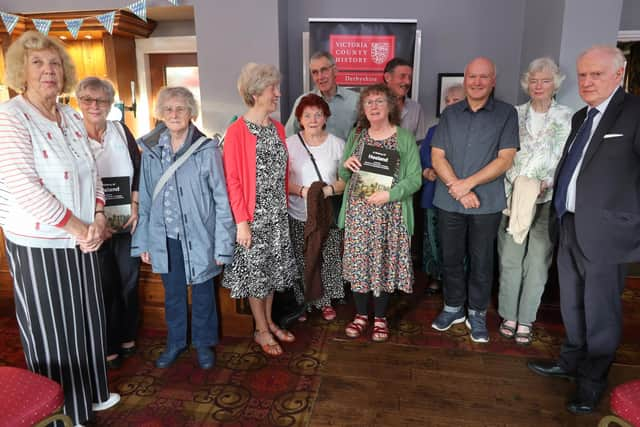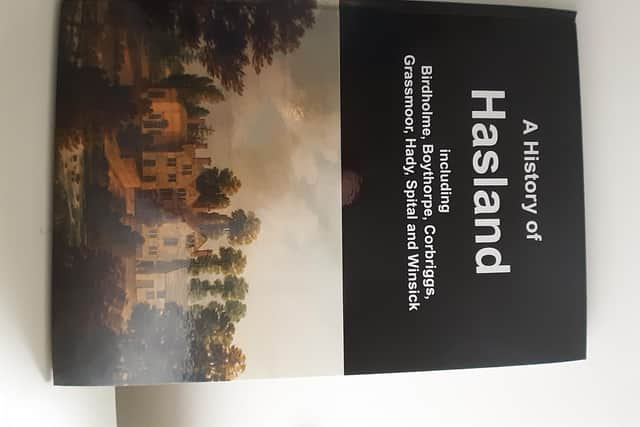New book about Hasland looks back at housing development, schools, shopping and industry in areas on doorstep of Chesterfield
and live on Freeview channel 276
A History of Hasland including Birdholme, Boythorpe, Corbriggs, Grassmoor, Hady, Spital and Winsick is a riveting page-turner for people interested in learning more about homes, schools, shops, major employers and leisure activities down the years.
Chesterfield historian Philip Riden led the research team involved in compiling the book which has been produced by the Derbyshire Victoria County History.
Advertisement
Hide AdAdvertisement
Hide AdHe described the book as the fullest account of the history of Hasland published so far, and the first ever attempt to write the history of Grassmoor or Birdholme. Philip said: “We hope that by publishing our research it will herald a new understanding of


the area’s varied past.”
Land ownership, economic, social and religious history, and local government are charted in the book which includes photos and maps.
Generous benefactors are honoured in the pages including George Albert Eastwood who gave Hasland's Eastwood Park and a small park in Winsick to the communities. George also donated a site on Infirmary Road, Chesterfield and £25,000 for the establishment of a technical college in 1924. Bernard Chaytor Lewis, the last member of his family to live at Hasland Hall, donated a village hall and built six almshouses in Hasland in memory of his parents.
The publication describes how Baden Powell Road, Redvers Buller Road, Lord Roberts Road and Dundonald Road in Boythorpe were named after commanders in the South African War at the turn of the 20th century. The curiously-named Jaw Bones Hill in Birdholme, is derived from the erection of a whale's jaw bones at the top of the hill prior to 1837.


Advertisement
Hide AdAdvertisement
Hide AdDuring the development of Spital in the 19th century, plans were passed for homes on Alexandra Road, Stanley Street, Spital Lane, Hartington Road, Quarry Bank Road and Valley Road in Spital, together with five shops. In 1891 Oscar Mason, who lived in Spital House, bid for an off-licence for the hotel he planned for the estate but was unsuccessful. It wasn't until 1922 when the Spital Hotel was built that alcohol was permitted to be sold on the estate and Chesterfield Brewery Company had to sacrifice two of its pub licences on Packers Row and Knifesmithgate for the privilege.
The book reflects the changing face of shopping. In the 1850s, Hasland had six shops and a book seller. By 1912 there were eight general shopkeepers, seven grocers, six drapers, five butchers and several other shops. In the 1930s Grassmoor had nearly 50 shops including a cycle dealer, three hairdressers and a chemist.
Schooling through the years makes compulsive reading. There are reports of overcrowded classrooms, uncertified teachers and senior pupils having to cover for absent staff. A heavy workload may have contributed to the breakdown of a headteacher at Grassmoor County Junior School prior to the Second World War. At that same school during wartime in the winter of 1941, snow drifts rendered the air raid shelters unusable and pupils had to huddle under their desks when the siren sounded.
The book highlights major companies such as Chesterfield Tube Works where 1500 men were employed during the First World War making aircraft tubing, oxygen cylinders for aircraft, explosion vessels, torpedo tubes and more than 2.5million shell bodies. During the Second World War the company produced for the Royal Navy more than 6,000 torpedo air vessel bodies, boiler drums for corvettes and frigates and heavy forgings for shells. For a time during 1942-72 the company was one of the largest producers of cylinders in the world.
Advertisement
Hide AdAdvertisement
Hide AdBryan Donkin Ltd also made a huge contribution to the war effort which included furnaces for aircraft factories and plant for national newspapers. More than a thousand 2,000lb bombs, received as rough castings, were machined and fitted at Chesterfield and workers machined wheels for Churchill tanks. In the early Fifties Donkins employed 1,000 men and women in Chesterfield.
Interestingly for an area that was dominated by heavy industry for most of the 20th century, just one such business remains in Chesterfield. The town not only houses United Cast Bar Ltd's sole UK foundry but it is also the only international group in any sector to make Chesterfield its headquarters.
Grassmoor's rich heritage of coal mining is documented in the book. A prosperous year in the 1870s saw 45,000 tons of coal mined in Grassmoor sent to London. In 1929 Grassmoor was the first colliery in Derbyshire to install pithead baths and in 1941 was the first canteen at any pit in the country to provide full meals. Between those dates, tragedy struck when 14 miners were killed and eight injured, with the pit owners and managers prosecuted for employing more than ten men in part of a mine with only one means of exit and for unlawfully storing explosives in the pit.Spital used to have a lace mill until the mid 1800s when the premises became a tobacco factory. Later in the 19th century, the mill was the largest employer of women in the town but a drop in demand for twist tobacco led to the demise of the business. The mill was later used for cabinet making, then became a joinery company, before moving into the sale of tiles. Spital Tile Company closed in 2019 and became a gym and dance centre.Numerous families, businesses and organisations are namechecked in a book that resonates with its reader, whether they live in the areas or not.
A History of Hasland costs £20 and is now on sale at Chesterfield Visitor Information Centre in Rykneld Square, at Waterstones in Vicar Lane Shopping Centre, Chesterfield and at the Co-op on Mansfield Road, Hasland.